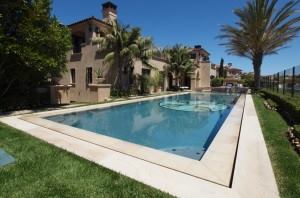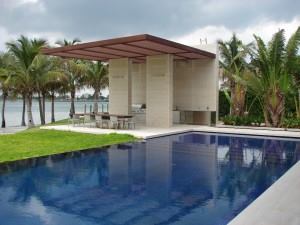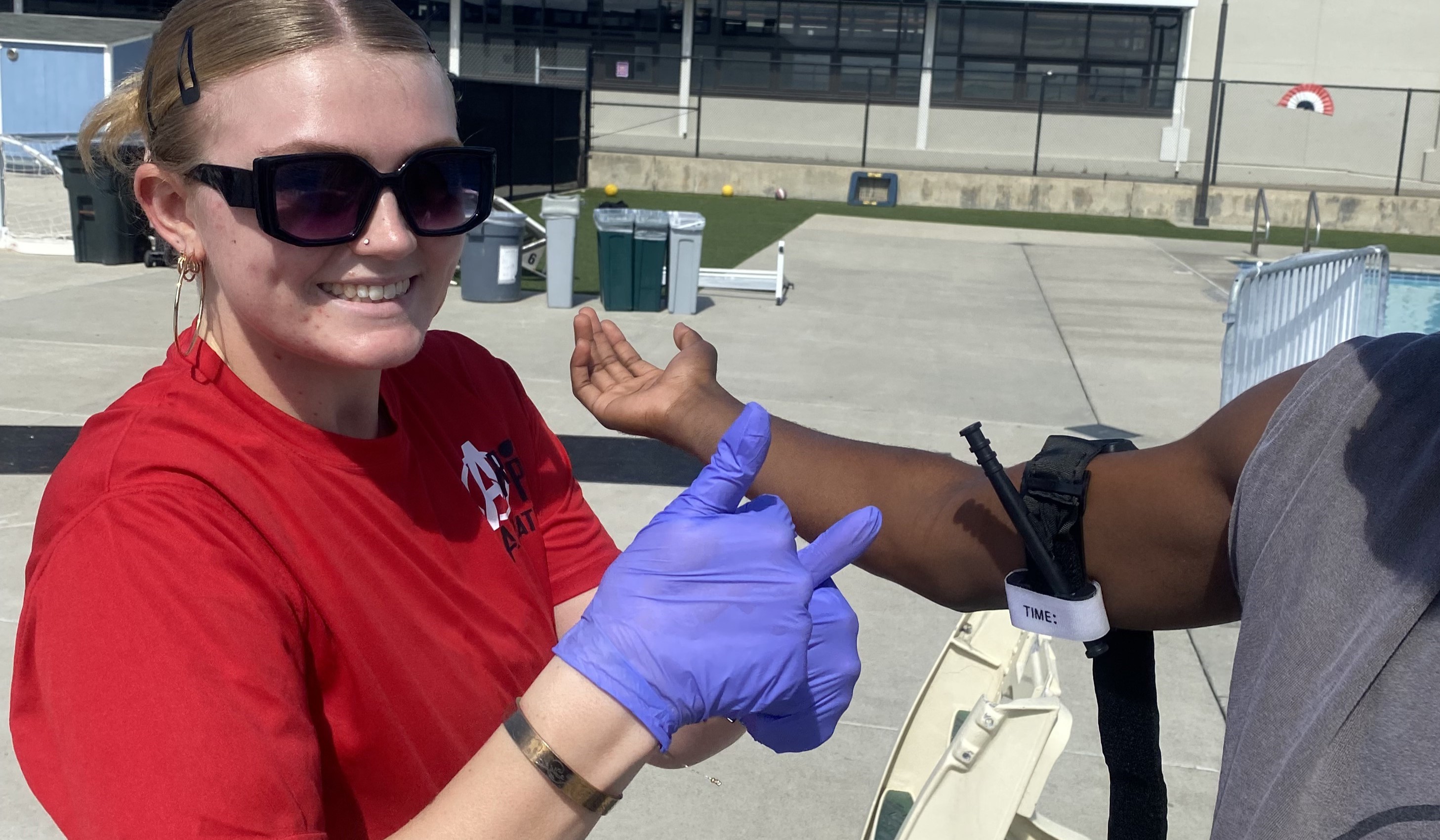
Nick Orabovic
It’s been more than a decade since perimeter-overflow designs hit in a big way, so veterans have had the time to hone their systems.
But the construction of these waterscapes has not come close to being standardized throughout the industry. Sure, most jobs will have a gutter surrounding the pool, a holding tank storing the extra water and plumbing to connect them. But perimeter-overflow systems still remain very specific to each project — and the builder constructing it.
“It seems every one of our projects has different details,” says David Peterson, president of San Diego-based Watershapes Consulting and the Education Council Chairman for Genesis. “It comes down to the architecture of the pool and what we’re trying to do.”
And over the years, some have found new ways to apply perimeter-overflow technology to meet their clients’ needs, both aesthetic and practical.
But whether the pools are designed with traditional commercial-style grates, a slender notch around the coping, or a raised wall all around, there are some things on which experienced contractors agree. That’s because certain hydraulics principles leave little room for interpretation, and builders have found the best ways of conforming to them.
Consider some of the main issues on which professionals have come to consensus, those where they haven’t, and learn about some of the interesting new ways the technology has been applied.
Gutter configuration
Builders have tried many versions of gutters.
Some have been less than successful. “I’ve seen gutters made out of PVC pipe, I’ve seen people make them out of … sectional gutters, like they use for drainage in parking lots,” says Paolo Benedetti, president of Aquatic Technology Pool & Spa in Morgan Hill, Calif. “It’s not the smartest thing because things leak. But I’ve seen guys … try to seal them with silicone and polyurethane and then they bolt together, [but when] you get a little movement they open up.”

These days, most veteran perimeter-overflow builders stick with masonry or concrete gutters, with stainless steel sometimes used, especially if access makes masonry or concrete too difficult.
SEE MORE: Backyard Inspiration
Many contractors still slope their gutters to help direct the water to pick-up points that lead to the holding tank. But others no longer do this. Benedetti builds the bottoms of his perimeter-overflow gutters level, so it’s easier for crews to shoot or pour. But to help the water find its way, he’ll have the crew create cutouts around the pick-up lines, which he runs horizontally, creating low points in the gutter.
“So it’s like a scupper or a little dropped gutter where that pipe comes in,” Benedetti says. “When water starts building up in the gutter, it’s going to start flowing off to the sides until it finds the low spot.”
He makes sure there’s enough flow in the gutters to avoid stagnation, and the inside of the gutters are finished smooth, so he doesn’t have to worry about debris getting caught on rough spots.
Over time, Benedetti’s gutters have changed in another way: In many cases, they’re narrower and deeper than in his early perimeter-overflow installations.
This adjustment isn’t related to hydraulics, but rather to the coping. In many cases, builders support the coping that sits over the gutter with stainless steel components and bracketry. In many cases, Benedetti would rather avoid this added cost for his customers, since it’s something that can’t be seen.
Now he builds his gutters to help the coping stone better support itself. Where they used to be 8- to 10 inches, now they generally range from 6- to 8 inches in width. This way the stone doesn’t have to cantilever out as much.
But the choice of coping material is important here, too. “I’m using a little thicker stones and picking stones that are strong enough to cantilever over without any support,” he says.
The necessary thickness of the stone depends on its natural strength. Some varieties can be 2 inches thick, while others will need to be 3 inches. Softer varieties like travertines and marbles are best avoided unless you want to work with stainless steel components. Instead, Benedetti gravitates toward bluestones, granites and the denser limestones. Wood also works.
Noise abatement
While individual builders may differ in their approaches to moving water through the system, the prevention of noise is one area in which there is plenty of consensus.
Perimeter overflow pools are striking in their sleekness, which often gives off an elegant and calm air. This can be ruined if there’s a persistent sucking or slurping sound coming out of the gutters. The noise occurs when water fills the pipe in its haste to leave the gutters and head to the storage tank. When the pipe fills, the water will push air down. The air needs to escape, so it moves up through the water, causing that sound.
Builders agree across the board that, to avoid this problem, you must make it easier for the air to move around in the pipe. First, contractors should use larger-than-normal plumbing so that the water never completely fills the pipe. This provides a little area for the air.
They differ on how large. For instance, Steve Sargent, president of Elite Custom Pools in Lake Forest, Calif., will work with 6-inch plumbing most of the time, leaving plenty of room for air and water to coexist without the need for bubbles pushing their way through.
Peterson uses a different approach: He doesn’t like to use plumbing larger than 4 inches. If the calculations suggest a 6-inch pipe, he’ll instead use two 4-inch lines. He believes this will create less of an echo, just as surely as a straw will have less of an echo than a tunnel.
“When you start getting really large pipes, you can have some really loud echoes in them,” he says. “It’s not as pronounced, I think, with the smaller pipes.”
However, he won’t go below 3 inches. “Anything smaller could get plugged up pretty easily with a leaf or something,” he says.
Next, the air must be given an easy path or an escape route, depending on the space available around the gutter. The best approach is to orient the pick-up pipes in a horizontal fashion.
“I’m trying to eliminate that shower drain noise,” Sargent says. “Any time you have water falling vertically, you have a shower drain noise — and nobody likes that.”
If the lines run horizontally and they’re sized large enough, the water will remain on the bottom and the air can move around at the top.
“You eliminate that whole issue, as long as your horizontal pick-ups are big enough that you’ve got some freeboard in the top of the pipe, [to accommodate] some air,” Benedetti says.
He has found a way to simplify the setting and connection of the horizontal pick-ups. This solution lay with the placement of the trunk line — that run of plumbing that carries water from the gutter to its ultimate storage place.
Whenever he can, Benedetti places it outside the pool shell.
The trunk line should gradually slope to the holding tank so the water is gravity fed. Benedetti’s crews set that first to the right slope. “Then as the plumbers are installing the pick-up lines from the gutter, they just come out, meet the trunk line, and rotate the tee so the angles match,” he says.
But horizontal pick-ups are not always possible. Sometimes the pool sits right next to the home or other structure, or other space restrictions exist.
In these cases, builders should outfit the gutters with snorkels, which are smaller pipes that provide air with an escape route to the top.
“If the air, instead of going back up through the water, can simply sneak out of the snorkel and go up this line that’s dry all the time, then you’ve eliminated the noise,” Peterson says.
How to store
The question of whether to use pre-made holding tanks or build them from concrete or masonry remains a matter of builder preference and needs of the specific job.
Sargent, for one, gravitates toward pre-made tanks. But he has stopped using polyethylene and moved toward fiberglass.
“A fiberglass tank is … a forever deal,” he says. “The only issue you’d have there is if the tank connections leaked for any reason. But [on our tanks] they’re all molded in — they’re threaded and molded fittings that are fiberglassed right into the shell so that we don’t have failures.”
These tanks are fairly pricey, but they make sense for his very high-end clients.
When using these containers, only select from those rated for potable water, not those meant for septic applications.
Peterson also recommends against ordering tanks custom fabricated from PVC sheet. Being buried in the ground, these tanks must hold up to a lot of weight from wet soil — with more weight bearing on it the deeper it is in the ground.
“When you try to take a flat surface like that, even if you put a bunch of ribs in it, the flat surfaces want to deflect,” he says. “They want to bend in all different directions. Once you start stressing all that out, the corners start getting weak, and eventually you end up cracking the plastic.”
For underground tanks, Benedetti definitely prefers concrete or masonry, sharing a wall with the pool if possible. He finds this simpler and more efficient than building a separate four-sided tank, and it eliminates the hydraulic complications that come from running a long trunk line to a remote container.
CMU blocks may be the easiest way to go when access is an issue. If choosing this option, Peterson says, the blocks need more reinforcement than normal. There should be rebar in every cell. “If you’re doing a water-retaining structure, we always state that the bars are every 8 inches on center,” he says. While he typically uses No. 4 bars, sometimes No. 3 will work.
The blocks should be filled with concrete and the tank waterproofed thoroughly.
Water savers
One would probably never think of using perimeter-overflow features to save water, but some builders have done precisely that.
Brian Van Bower often designs his systems to store rainwater so that it can be used to top off the pool, eliminating the need to use the tap.
“One of the things that got me interested in rainwater harvesting is … in Bermuda all of the rooftops on almost every single home are set up to catch all the rain that lands there and funnel it into a cistern under the house,” says the president of Miami-based Aquatic Consultants and a Genesis cofounder. “When you think about it, that makes every bit of sense in the world.”

Timely solution: Raised perimeter overflow pools, or those that combine a slot detail with a traditional vanishing edge, are subject to more evaporative water loss than the average pool. To combat this, some builders oversize their gutters to store rainwater to top their pools off.
When he can, Van Bower will slope the deck toward the pool more than the traditional 3 feet back. In fact, he’ll do it as far back as he can manage. This will corral as much water as possible toward the slot or grate and into the gutters.
Next, he oversizes the holding tank and perhaps even the gutters to accommodate the extra water. Now the homeowner has a system that stores and treats rainwater that can be used to make up for evaporative loss.
This especially makes sense for raised perimeter-overflow systems, or pools that combine a slot detail with a traditional vanishing edge. These installations are more subject to evaporative loss because the falling water is exposed to the atmosphere and wind.
It also offers an extra benefit: It eliminates the sometimes awkward peak caused when changing the deck’s slope from toward the pool to away from it.
But if you’re interested in trying this strategy, make sure it meets code, Van Bower says. Some local building departments insist that the deck be pitched away from the pool beyond the first few feet.
Peterson also tries to prevent water loss on his perimeter-overflow pools, but his approach is a little different: He is trying to capture as much splashout as possible while also enabling more seepage into the water table.
He starts with an extra slot around the pool. On one project, he is having 20-by-20-inch custom pre-cast pavers made. These large pavers are being used throughout the deck and brought directly to the pool. Then, to prevent water loss from splashout, Peterson will place a second slot around the pool, around the back of the paver.
“As water splashes out across the deck, I essentially have one more point to pick up the water, because 20 inches back is another 1/ 8-inch gap to grab the water,” Peterson says.
The gutter is sized wider than normal to sit under the second slot.
Then throughout the deck, Peterson will set the pavers individually and without grout joints, creating what Peterson calls a “floating paver detail.” This allows water to seep between the stones and soak into the ground. “It’s kind of a green detail,” he says. “Because it’s not sending all this water out to the street. I’m collecting it into the groundwater.


